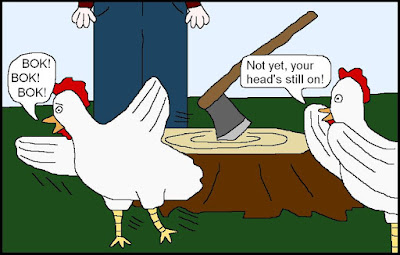US Legs will Shake the Legs of Indian Industry
US Chicken legs will Shake the legs of Indian Poultry Industry
It is high time Indian Poultry industry must learn from experience of Vietnam poultry trade.
India's Response to US Chicken legs ruling:
- It is the time that Indian Poultry Industry must think how to put house in order to face the competition on horizon.
- There are many traders and poultry players those who will offer their services to import the chicken legs from US and act as their distributors.
Industry Claims that US chicken is being ‘dumped’ in
Vietnam have been fervently denied by the head of the USA Poultry and Egg
Export Council (USAPEEC)
Local media reports that
US chicken is being sold at prices much lower than domestically produced
products has angered poultry farmers in the country. The claims come at a time
when Vietnamese poultry producers are already struggling to remain profitable
in the face of high prices for feed grains.
"US chicken parts
are sold in Vietnam at the same or higher prices than in the United States, so
under World Trade Organization rules they are not being dumped," USAPEEC
president Jim Sumner, has said in response to the claims.
"US sympathetic to
local poultry producers"
"We are very sympathetic
that this situation is affecting local producers," Sumner said.
"Consumers should keep in mind that the complaint is about US frozen leg
products that do not directly compete with fresh locally produced whole
chickens, which is the preferred product of Vietnamese consumers."
Sumner said that USAPEEC
and the US poultry industry had always been supportive of the Vietnamese
poultry industry, conducting various seminars and workshops aimed at supporting
food safety and biosecurity practices for the local poultry industry.
"In the early
2000s, USAPEEC came to the assistance of the local poultry industry during the
devastating avian influenza crisis, developing materials aimed at informing
Vietnamese consumers that cooked poultry was safe and encouraging consumers to
support their industry."
US chicken leg quarters
Two-thirds of the chicken leg quarters produced
in the US are consumed in the US. Those remaining are sold to more than 125
countries around the world, including Vietnam at similar prices as in the US.
India is preparing a second line of defence to protect its domestic poultry industry against competition from cheap chicken leg imports from the US.
With the World Trade Organization
recently ruling against India’s ban on chicken import from the US on the
grounds that it would lead to spread of bird flu, the Commerce Ministry has
asked poultry breeders to work out fresh risk assessments that would better
withstand scientific scrutiny. (Corporate such as Venky’s and Suguna are likely
to be affected by the ruling.)
“We are going to challenge the WTO
ruling soon, but we have to be ready for a possible negative outcome. That is
why we have asked the poultry industry to get other possible health risks
assessed,” a Commerce Ministry official said.
Taking a hit
India’s over four lakh poultry
farmers, who produce an estimated 3.5 million tonnes chicken annually, could
take a severe beating if cheap chicken legs from the US flood the domestic
market. India’s poultry industry, worth an estimated ₹50,000 crore, is the
fourth largest in the world after the US, China and Brazil.
As US chicken legs are priced much
lower than ones from India (Americans, unlike Indians, don’t savour legs),
domestic breeders are apprehensive that they may lose up to 40 per cent of their
market.
Many countries including several in
the EU and Australia do not allow import of chicken from the US on various
health grounds that pass the WTO scrutiny.
India’s concern that low pathogenic
strains of bird flu (that is occasionally found in chicken from certain parts
of the US) posed health risks was dismissed by the WTO as being scientifically
invalid. New Delhi has time till January 26 to file an appeal against the
ruling. The Commerce Ministry feels that it stands a better chance at retaining
the import ban if it can issue fresh orders based on a more valid health
concern.
“Risk assessment could be done on
factors such as US poultry being fed genetically modified food or the fact that
frozen chicken is kept in that state for long periods,” the official said.
However, New Delhi has to steer clear of risks related to factors that may not
be under control in the domestic market.
Health concerns
For instance, the EU decision to ban
US poultry on grounds that chlorinated water used by poultry breeders in the US
posed health risks can not be cited by India where water is chlorinated as
well.
“In our recent meeting with poultry
breeders, we have asked them to carry out risk assessments from reputable
institutes with international experts. The restrictions that we impose have to
be defensible,” the official said.
The Way Forward:
Please use upcoming Poultry Federation of India and CLFMA Regional and Annual Meeting to have serious discussion because the way Indian poultry industry is operating - highly fragmented and struggling to survive from competition within. In existing framework, it will not be able to face the competition from international products.
Please keep in Mind - AVERAGE CONSUMER WILL ALWAYS GO FOR VALUE FOR MONEY - NOT JUST MADE IN INDIA. INDIAN INDUSTRY MUST GEAR UP TO MEET CHANGING CONSUMER EXPECTATIONS and ASPIRATIONS.
I strongly believes that consumer buy their choices based on value for money (besides some brand obsessions) but not always based on nationality.
I strongly believes that consumer buy their choices based on value for money (besides some brand obsessions) but not always based on nationality.
When domestic industry makes defective, substandard and adulterated products, are they nationalist? Should Indian consumers support them? Definitely Not. So, If domestic industry can't be nationalist, why consumer should be?
Consumer has a right to choose, which she must exercise her right.



Comments
Post a Comment